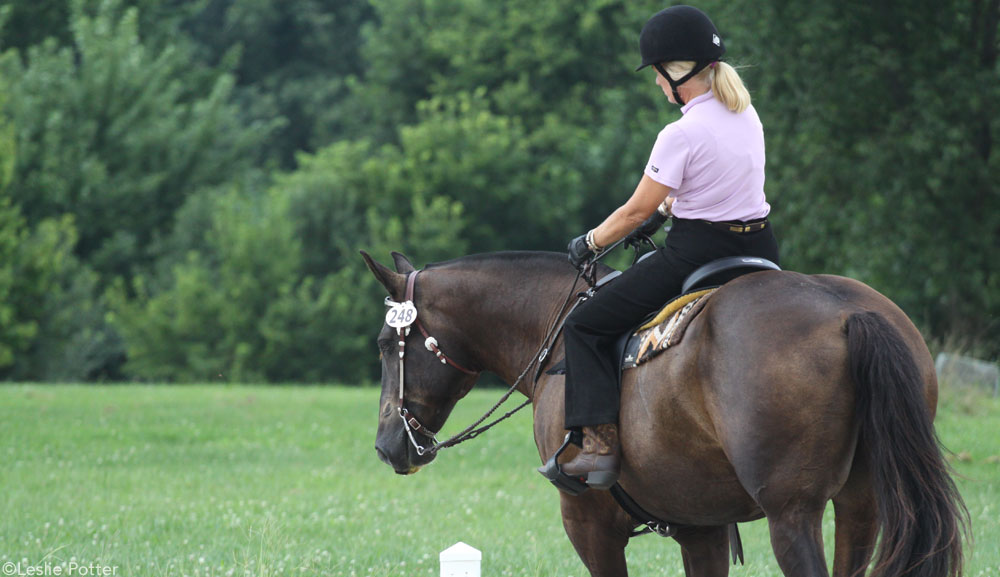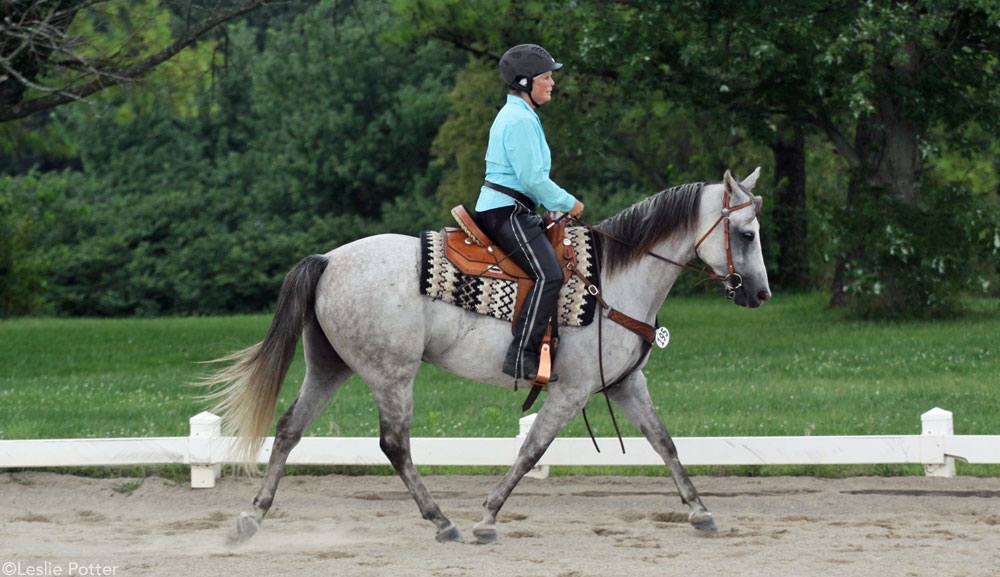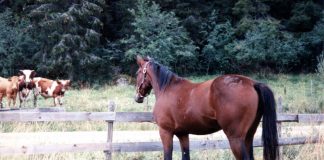
Exercises that ask your horse to bend and move sideways, such as leg-yielding (known in the western world as two-tracking) and shoulder in, will improve your horse’s balance by enhancing his ability to use his hind end. A horse that travels in balance, with the stride of his hind legs equal to or surpassing the reach of his front legs, will be more agile and quicker to respond to the rider’s cues. Other advantages are smoother more efficient gaits, with reduced knee and hock action, and improved cadence. Dressage also promotes self-carriage, which means the horse will be able to do his job with less assistance from the rider.
Begin With a Bend
Bending teaches your horse how to be soft in the bridle and pliable throughout the length of his body. Lateral movements take your horse in a new direction, quite literally. They include any of a series of exercises that move either your entire horse and/or an isolated section of his body to the left or the right of a path on which he’s traveling. They are excellent for developing the muscles of the topline and hindquarters, which your horse needs for slow, collected gaits. In preparation for tasks such as lope transitions, pivots on the front and hind ends, and lead changes, they are indispensable.
The bend is the foundation for all other suppleness exercises. It’s essential that your horse bends correctly at every gait with his body perfectly aligned from head to tail, mirroring the shape of the arc, arena corner or any other curving path that he travels. Help your horse execute beautiful bends by sitting squarely in the saddle with your hips relaxed and your weight evenly distributed between your left and right stirrups. Your rein length and contact should be even, but your inside rein needs to be short enough to create the right amount of bend in your horse’s head and neck. The inside rein determines the degree of bend and establishes the inner boundary of the path your horse is following. Your outside rein prevents your horse from overbending by creating the outer boundary. Both reins form a tunnel of sorts, and your horse moves down the middle of its borders. Ride with a snaffle bridle, and make sure that your hands are level and square with each other. Hold the reins as softly and quietly as you can so that the bend is as consistent as possible. Use your legs to ensure that your horse is traveling with a long and even stride by driving him forward whenever he reduces the rhythm or speed of his gait.
The ultimate goal is to have a horse that is capable of bending his body evenly in both directions with relative ease on both very small and very large circles. To transform your stiff steed into a pliable pretzel, try riding him on a figure-eight. For this exercise, a figure-eight looks like two circles connected in the middle by a straight line. At the walk or jog, send your horse down the middle of the figure-eight with his head, neck, and shoulders centered between your reins. Your hands should be about 10 inches apart. Start the left bend by shortening up your left rein first then adding light and steady contact with your right rein so that your horse’s body is equally supported from both sides. The supportive outside rein will encourage him to shift his weight rearward and help his body stay in alignment.
Your horse’s inside nostril should lead the rest of his body into the turn. If he doesn’t bring his nose to the inside, nudge him gently with your left heel. If he drifts to the outside of the turn or slows down, press or nudge him with both legs. Once he gets through the left-hand turn, even up your reins and allow him to take several steps down the straightaway. Next, shorten your right rein to bend your horse into the right-hand arc.

Whether or not your horse is bending correctly on the arcs will be apparent as soon as he’s traveling straight along the centerline. A horse that bends correctly is carrying himself in balance, so he’ll be able to straighten up without changing his pace or drifting left or right. However, if your horse was stiff or unbalanced in the turn, you’ll notice that he’ll wander, stall out, or speed up when you guide him on a straight line.
Practice figure-eights of various sizes and at varying speeds to stretch and tone your horse’s muscles for greater suppleness and flexibility—key ingredients for optimum performance.
Once he’s got the bending work down pat, it’s time to take him to the next step … sideways.
Two Tracking/Leg-Yielding
The leg-yield offers multiple benefits. It challenges the horse to move forward and sideways simultaneously, like a sidepass on the go. The forelegs and hind legs cross over one another as your horse continues to move forward. Your horse will make use of the muscles of his hips, buttocks and topline to perform this maneuver. As his legs move laterally, he will also reach through his shoulders, and he’ll be lighter on his front end. The exercise strengthens your horse’s hind end and back, and loosens up his shoulders and hips, improving balance and creating a longer, more cadenced stride.
Once you’re ready to tackle a leg-yield, outfit your horse in a smooth snaffle and walk him in a straight line parallel to, and about 20 feet away from, an arena rail. Be certain that your reins are even, your arms are relaxed, and your hips are soft and moving in rhythm with your horse. Hold your hands evenly and level with or slightly behind the saddle horn.
If you are leg-yielding your horse to the left, away from your right leg, ask him to bend his head and neck ever so slightly to the right, away from the direction of travel. If you can see more than the eyelashes of his right eye, he’s bending too much. Soft contact with your left rein will support your horse’s neck position and prevent overbending. Throughout the maneuver, your horse’s neck should be part of a continuous unbroken line that begins at his withers and follows the entire length of the neck to his poll. Your job is to create a consistent and even bend down that line. Keep an eye on the topline of you horse’s neck for signs that his neck has shifted out of alignment and adjust your reins as needed to bring it back to center.
To get started, shift your hips slightly left in the saddle to stay over his ribcage when it moves laterally, and pull your shoulders back over your hips to keep your weight off your horse’s front end. Press your entire right leg against your horse’s side in the middle of his ribcage. If he doesn’t move over, nudge him over with your calf or heel, and then go back to steady pressure. Remember that your horse has to continue to travel forward as he is moving to the side.
Don’t be surprised if your horse’s front end moves over and his back end doesn’t. Just make sure his neck is nearly straight, and slide your right leg farther back to connect more with his hind. Whenever your horse gets crooked in his body, abandon the leg-yield until you re-establish correct alignment in his body on a straight line. Reverse the process for a leg-yield to the right, and use the same sequence of events when you’re ready to try it at the trot, which is easier because your horse will have more forward motion.
Reverse Arc
After your horse has mastered the leg-yield, give the reverse arc (counter-bend) a try. It is exactly what it sounds like: Your horse moves on an arc, let’s say to the left, but his body is bending to the right. It’s great for strengthening the hind end, improving cadence and loosening up the shoulders for flatter-knee gaits with more reach.
Ride your horse on a circle to the left with his body conforming to the circle’s arc. Then, with your left leg about an inch behind the cinch and your right leg completely off his side, push your horse away from that circle and onto a circle to the right. You will be changing the direction of your circle without changing the direction of your horse’s bend.
During this exercise you’ll maintain the original bend with a shorter left rein and supportive contact on your right rein. As you push your horse over with your left leg, keep your hands about 10 inches apart and simultaneously move them one or two inches to the right. That will bring your horse’s head, neck and shoulders into the new direction in a reversed arc. This exercise can be performed at any gait, but stick with the walk until he feels comfortable, then give him time to master it at the jog before trying it at the lope. In the beginning, ask for just a few steps at a time and keep your counter-bent circles and turns large and sweeping to give your horse a chance to become accustomed to the work.
If your horse slows down or tries to quit, immediately return to a normal arc and re-establish his momentum before trying the counter-bend again. Reverse the procedure for a counter-bend to the left. Make sure he has plenty of forward energy before you try it again. He has to maintain a steady pace to reap the benefits of the exercise. However, until your horse develops the strength and flexibility to maintain it for longer periods of time, only ask for a couple steps in the reversed arc before allowing him to go straight or returning to a regular bend.
Shoulder-In
If you are looking to improve self-carriage and help your horse develop the strength and flexibility he needs for collected work, the shoulder-in will get the job done. If you stand directly behind or in front of a horse performing a shoulder-in you will see that his shoulders quite literally move to the inside of the track of his hindquarters. It’s a subtle shift that brings the outside foreleg in line with the inside hind leg as the horse continues to travel on a straight line.
You’ll ask your horse to do a shoulder-in on the rail. Shorten your inside rein to bend his head and neck away from the rail. Hold your inside hand next to his withers without crossing over the top. Bring your outside hand toward his withers on the other side, keeping both reins parallel with each other. Put a slight twist in your upper body so that you are turning away from the rail and into the direction of your horse’s bend, but keep your hips square with the saddle. Apply steady pressure with your inside leg at the cinch. Bring your outside leg back and maintain light contact with the middle of your horse’s ribcage. Keep it passive, but if your horse loses impulsion from his hind end apply pressure to encourage him to keep his stride strong and even. You are trying to support your horse’s front end with your inside leg and get him to bend his shoulder around it, so be careful not to bump him or push so hard with your leg that he wants to move away from it.
From the saddle you’ll want see your horse’s withers, neck, and head curve to the inside of the rail as his shoulders shift to the inside of the track. Through your seat bones feel whether or not your horse’s hindquarters are tracking straight along the rail to tell if he’s performing the maneuver correctly.
Stretch It Out
Bending and lateral exercises demand a lot from your horse physically, so periodically give him a chance to stretch his hard-working muscles with a trip around the arena in a long and low frame. Lengthen your reins and see if he’ll stretch his neck down to release his neck and back. If he doesn’t do it on his own, take steady contact with your reins and hold your hands wide and even with the pommel of the saddle. The trick is to only establish contact by taking the slack out of the reins, instead of pulling back on your horse’s mouth. Maintain the pressure until he lowers his head, and then
release it. Softly bump the inside of your calves against his sides to encourage him to step under himself with his hind legs if he leans on your hands or elevates his head.
Always take into account your horse’s fitness level when you are asking him to perform difficult exercises. Be happy if he can maintain a specific bend or movement for one to four steps at first, then slowly work your way up to holding it for longer periods of time. It might be tempting to try doing everything at once, but that will put too much physical and mental pressure on your horse.
These exercises will improve your horse’s balance and help you develop a greater awareness of how he uses his body. They will also enhance communication between you and your horse, bringing your riding experience to a higher level.
Further Reading
Extend the Jog and Collect Benefits
Western Pleasure Headset
This article originally appeared in the May 2005 issue of Horse Illustrated. Click here to subscribe.






I liked it, very informative and fairly easy to follow. The only other thing I wish the article included was visuals, but one can’t be too picky I guess. Thanks for the great article. =)
It was Wonderful. Really what I need to read. I don’t always understand things as quickly as I did when I was younger, so this is great. Thanks
I’m going to have to try and do more of this stuff.
i just got in to western with my horse and this is so helpful!